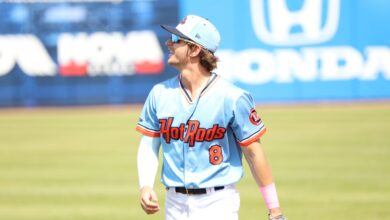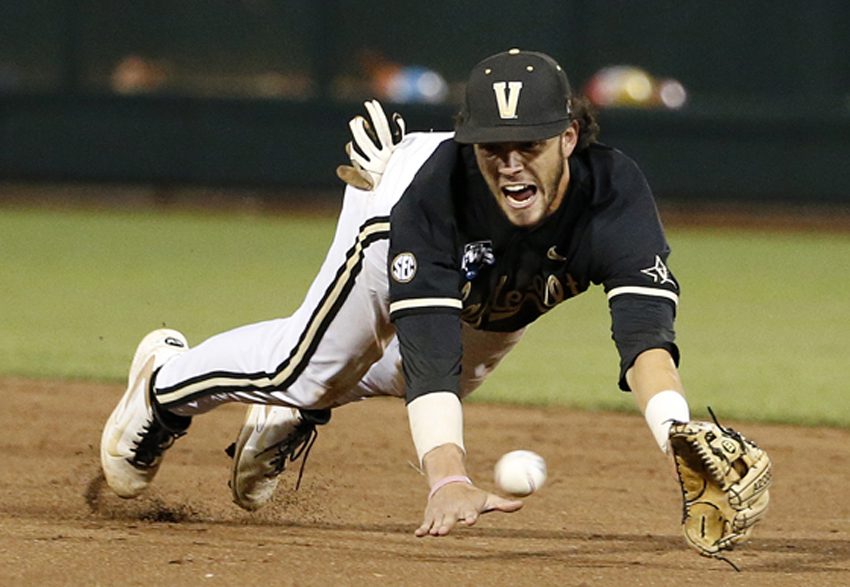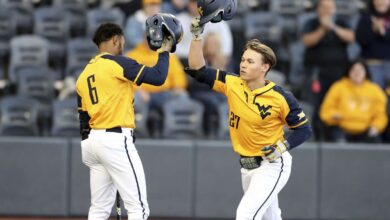

The name is familiar, especially if you were a Cubs fan in the mid-80s to early-90s. The game, however, is different. Sure, there are similarities. The plus/plus speed, the canon arm, the love and endless enthusiasm for the game, and the all-out aggressiveness on the field are the same. The elder was a two-time All-Star and fan favorite on the North Side of Chicago for over a decade, and still remains so, well past his playing days. The younger is just trying to play his own game, make his own mark with the fan base and hopefully do something his dad never did: Help lead his team to a World Series title one day. That would be the end-all to any bragging rights argument in the Dunston household.
As for now, however, his dad holds the upper hand having the distinction of being the first overall pick in the 1982 amateur draft by the Cubs. He likes to jokingly brag about it, too, to junior, noting that Ken Griffey Jr., Alex Rodriguez, himself and Bryce Harper all went first overall. You can see the friendly, family rivalry between them that shows their competitive fire.
Dunston Jr. was the Cubs 11th-round selection in last year’s draft out of Valley Christian High School in San Jose, California. The draft is very different today than it was back in 1982. “Signability” is a word often heard come draft time these days. That word can cause a player to slip dramatically, even if the talent is undeniable. This was the case for Dunston.
For those who don’t know, Vanderbilt University is a baseball powerhouse, and anyone with a commitment there scares teams away. Just ask the Toronto Blue Jays, who took a gamble and selected Tyler Beede out of Lawrence Academy High School in Massachusetts with the 21st overall pick. Beede had a commitment to Vanderbilt. He was also the only first-rounder to not sign. Dunston had one of those commitments, too, and teams shied away for fear of wasting a pick on a kid who would never sign on the dotted line.
The Cubs had a plan entering the 2011 draft, however. They were going to take the best players available and outspend every other team to secure a deep and talented group that would bolster their depleted farm system. They offered Dunston, who was a top-50 prospect by Perfect Game Baseball and AFLAC All-American, a $1.275MM signing bonus, which is back-end, first-round money, and also offered to pay for his schooling. You don’t shell out that kind of money for a sentimental pick. Dunston uses his slipping to the 11th round as motivation.
Dunston grew up around the game. Because of his dad, he had advantages others didn’t. He got a chance to pick the brains of players like Barry Bonds, Justin Upton and Jose Reyes among others. He was able to watch the way they prepared themselves, the mental approach, the grind, all of the little things the average high school player never gets a chance to see until they make it. He also had the advantage of having his dad throw him batting practice. Dunston Sr. had one of the best arms at shortstop in baseball history. Mark Grace probably still has welts on his hand from his throws.
Something he didn’t learn from those players was his blistering speed, or his enthusiasm and aggressiveness for the game, although bloodlines surely played a huge part in it. Dunston runs a 6.5/60, and he once scored from second base on a dropped third strike. With his legs, arm and range, he is a true center fielder who will be able to stay at the position at the next level. He has known Cubs top prospect Brett Jackson for years, having grown up near him in California. Jackson was the team’s first overall pick in 2009 and is their number-one prospect. He also plays center field. Dunston dreams about playing alongside him in the majors, with Jackson in a corner outfield spot, of course.
At the plate, he has exceptionally quick hands, some of the quickest in his draft class. He bats left handed, and with his all-out swing, he never gets cheated. At 6’-2” and 180 lbs, and getting bigger, he generates gap-to-gap power as the ball jumps off his bat having top bat speed. He can drop down a bunt when needed, draw a walk and has extreme confidence in his abilities at the plate.
(AFLAC All American batting practice footage)
Are there things he needs to work on? Of course. As with most teenagers, his approach at the plate needs refining. Identifying, and knowing when to lay off breaking pitches, as well as making consistent contact, are other areas of need. But he knows all of this, and is probably working on them as I write this.
At the Cubs’ Florida Instructional League, his first taste of pro ball, Dunston appeared anxious at times, maybe trying to prove too much. Over 14 games, he went 6-42 (.143) but did smack a home run and drove in four runs. He also only struck out six times, showing an already improved approach at the plate. With his first go-around in his back pocket, he will be more relaxed when he opens up the season at either short-season Boise, or Class A Peoria.
In a couple of years, when Dunston makes his debut with the Cubs, a new era will begin. The center fielder will, no doubt, make his own mark on the city and be a fan favorite for years. Just please, leave the Shawon-O-Meters at home.





